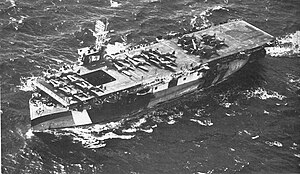USS Copahee (CVE-12)
 |
|
| History | |
|---|---|
| Laid down: | 18 June 1941 |
| Launched: | 21 October 1941 |
| Commissioned: | 15 June 1942 |
| Decommissioned: | 5 July 1946 |
| Struck: | 1 March 1959 |
| Fate: | Scrapped in 1961 |
| General characteristics | |
| Class and type: | Bogue-class escort carrier |
| Displacement: | 7,800 tons |
| Length: | 495.7 ft (151.1 m) |
| Beam: | 111.5 ft (34.0 m) |
| Draft: | 26 ft (7.9 m) |
| Propulsion: | 2 boilers (285 psi); 1 steam turbine; 1 shaft; 8,500 shp (6.3 MW) |
| Speed: | 16.5 knots (30.6 km/h) |
| Complement: | 890 officers and men |
| Armament: | 2 × 4 in (102 mm), 8 twin × 40 mm, 27 × 20 mm guns |
| Aircraft carried: | 24 |
The USS Copahee (CVE-12) was a Bogue-class escort carrier that served in the United States Navy during World War II. Originally classified AVG-12, was changed to ACV-12, 20 August 1942; CVE-12, 15 July 1943; and CVHE-12, 12 June 1955.
She was laid down on 18 June 1941, as Steel Architect, under Maritime Commission contract (hull 169) in Tacoma, Washington by Todd Pacific Shipyards, launched 21 October 1941; sponsored by Mrs. W. M. Wells; acquired by the United States Navy on 8 February 1942; and commissioned 15 June 1942, Commander J. G. Farrell in command.
Sailing from Alameda 5 September 1942, Copahee arrived at Nouméa 28 September with her cargo of planes, stores and passengers. From 7 October to 11 October, she cruised toward Guadalcanal to launch 20 marine fighter planes and 18 SBD-3's of VMSB-141 for Henderson Field, then returned to San Diego, California 29 October for overhaul.
After training at Pearl Harbor, Copahee sailed from San Diego 25 February 1943 to begin transport duty carrying aircraft, aviation stores and personnel to the forward bases in the New Hebrides, Fijis, and New Caledonia as well as islands in the Hawaiian chain until 7 June 1943.
Between 2 September 1943 and 19 January 1944, she made two voyages to deliver aircraft at Townsville and Brisbane, Australia, and one to Pearl Harbor. She sailed from San Diego 10 April to ferry aircraft from Pearl Harbor to Majuro until 3 June, when she began supporting the Marianas operation by supplying replacement pilots and aircraft to carriers of the 5th Fleet. On 28 July 1944, she returned to San Diego, California with a load of captured Japanese planes (13 Mitsubishi A6M Zeros and 1 Nakajima B5N "Kate") and equipment (37 engines) to be used for intelligence and training purposes.
...
Wikipedia
